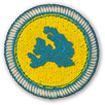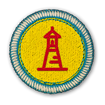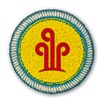Til hamingju is Icelandic for congratulations.
Now you have learned the A-Ö of Iceland and completed all of the regional classes. Hope you had some fun!



For centuries the people of Reykjanes have sought their livelihood in the abundant waters surrounding the peninsula. Cod is the most important catch, and the region specialises in producing delicious bacalao that is sought after by restaurants around the world.
This proud fishing tradition is brought to life at the Icelandic Saltfish Museum in Grindavík, which recreates life in the town in the 1930s. Reykjanes is also an ideal place to sample the catch, with a number of restaurants serving fish as fresh as it comes.


Sigur Rós found international acclaim with their second album, aptly titled Ágætis byrjun – “a good start”. Just as the album has served as a gateway to Icelandic music, most visitors get their first taste of Iceland at Keflavík airport, which lies just a few minutes from the town proper.
Keflavík is a logical kickoff point for exploring the region, as it is close to numerous natural wonders and home to popular museums such as Viking World and the Icelandic Museum of Rock ’n' Roll. The town also has a number of good restaurants, accommodation and various other services and activities, all within easy driving distance from the capital.


Iceland may seem like an unlikely place for outdoor swimming, but with plentiful geothermal water, it’s a way of life at every time of year. Reykjanes is home to no fewer than six excellent swimming pools, all of which also have hot tubs – ideal for a relaxing soak after a busy day of romping around the region.
Most of them also have water slides, kids’ areas and steam rooms. The biggest facilities are at Waterworld in Keflavík, though every pool has its own unique charm.


Legend has it that a ghost named Gunna terrorised the inhabitants of Reykjanes, wreaking havoc during the 18th century until a priest trapped her in a hot spring. Today the area still beares her name, Gunnuhver (“Gunna’s spring”), and with its eerie mists and otherworldly colours, it’s easy to imagine how such a tale arose.
Gunnuhver is not only haunted, it is also home to the largest mud pool in Iceland, spanning 20 m across a basin of bubbling sludge. The largest spring is surrounded by several smaller pools and fumaroles, which together paint the landscape in vivid splashes of yellow, orange and ash grey.


At the edge of the town of Garður, you can find two handsome lighthouses. The older of the two was built in 1897 and stands stocky and square with two distinctive red stripes.
The newer lighthouse was built as a replacement in 1944 and is the tallest in Iceland, a graceful white cone 29 m in height. During the day this is the perfect spot to snap pictures and spot the busy birdlife, while in the evening it’s ideal for enjoying unfettered views of the sunset, or perhaps even the Northern Lights.


Eldey is a sheer-cliff island that juts out from the ocean some 15 km off the coast of Reykjanes, rising to a height of 77 m and covering an area of 0.3 km2. This rocky outcrop is the innermost island of a chain known as Fuglasker (“bird skerries”).
As the name suggests, these islands are home to a rich array of birdlife, with Eldey hosting one of the world’s largest northern gannet colonies. Around 16,000 pairs nest in its sheer cliffs every year.


Staðarborg is an intriguing sheepfold built from lava rocks skilfully stacked in a circle about 2 m in height and 8 m in diameter. Its precise age is not known, but it is believed to be several centuries old. According to local tales, it was built by a man named Guðmundur for the reverend at the nearby Kálfatjörn patronage.
Guðmundur had ambitious plans to close it with a conical roof, but the reverend was concerned it would become grander than his church steeple and stopped the construction. Today the sheepfold remains in excellent condition, just as it was built centuries ago.


Clint Eastwood chose parts of Reykjanes to shoot his 2006 film, Flags of Our Fathers. The peninsula’s black volcanic sands echo the beaches of the island Iwo Jima, making it the perfect location for his acclaimed war epic. Today it is possible to explore some recognisable shooting locations and see them in a very different context.


It is not difficult to see that Reykjanes peninsula is one of the most active geothermal areas in Iceland, with ethereal plumes of white steam emanating from much of the landscape. This geothermal power is put to good use at Svartsengi Geothermal Station, which pipes hot water to around 21,000 homes around the peninsula.
The station also gives rise to one of Iceland’s most popular destinations, the Blue Lagoon, which is famed for its healing ice-blue waters and incredible setting.


Landing at Keflavík airport, you’ll be greeted by the otherworldly lava fields that make up much of Reykjanes. Gnarled knobbles of volcanic rock are blanketed in velvety moss, which seems to almost glow against the landscape in shades of olive and pistachio green.
These fields are geologically youthful, with the newest formed by volcanic eruptions in 1226. It is possible to explore the fields on foot, though it is important to stick to marked trails, both for personal safety and also to protect the delicate environment.


Beneath the surface of Reykjanes lies a captivating hidden world. The peninsula is riddled with around 200 subterranean lava tubes, caves that form when a lava flow partially cools and crusts over before its liquid centre drains away.
One of Iceland’s most magnificent lava tubes is Leiðarendi in Reykjanes Geopark, which extends 900 m into the earth and is adorned with stalagmites, stalactites and other curious formations. Caves should only be explored with the help of a trained guide, and many tours run in the area.

Sports are a way of life in Reykjanes, with basketball dominating the winter months and football most popular in the summer.
The Keflavík basketball club is the most successful of its kind in Iceland, with its teams regularly sweeping national titles in all age groups.
As the weather brightens, football takes over, with people of all ages heading outside to enjoy a local match, be it on the field or from the stands.

Reykjanes peninsula lies upon plate boundaries along the Mid-Atlantic Ridge, part of the 65,000 km mid-ocean ridge that traces a winding path around the earth.
Reykjanes is the only place in the world where the Mid-Atlantic Ridge is visible above sea level, and in 2015 this unique landscape was formally recognised when the region became the world’s 66th UNESCO Global Geopark. The Geopark features 55 listed Geosites spanning four separate volcanic zones, with hundreds of open fissures and faults, craters, caves, cliffs, and black sand beaches to explore, all just a short drive from the capital.


Hvalsneskirkja is a handsome stone church located on the coast just south of Sandgerði. It was built between 1886 and 1887 using basalt rock collected from the local surroundings. The interior is made from driftwood scavenged from nearby shores – a necessary innovation given that no timber grows on the peninsula.
The walkway to the church is marked with the original headstone of Steinunn Hallgrímsdóttir, who died in 1649 at the age of just four. Steinunn was the daughter of famed minister and poet Hallgrímur Pétursson, who served in Hvalsnes for many years.


In addition to its natural wonders, Reykjanes also has a rich arts and cultural scene. Since opening in 2003, the Reykjanes Art Museum has earned a reputation for the quality and variety of its exhibitions, which feature works from some of Iceland’s most talented artists. The gallery is part of the Duus Museum, a cluster of exhibition halls that also house the Reykjanes Heritage Museum, the Old Cinema and the Reykjanes Maritime Centre.


Ljósanótt, the Night of Lights, bids adieu to the bright days of summer and welcomes the cosy autumn darkness. Despite its name, this delightful family festival takes place over five days every year, inviting guests to sample the best of the region’s culture and entertainment in the first week of September. Galleries open their doors free of charge; and live performances, market stalls, and kids’ activities pop up on every corner.
The festival culminates on Saturday night, with a free outdoor concert featuring some of Iceland’s most popular music acts, before closing out on Sunday night under a blaze of pyrotechnics.


There are few sights more beautiful than the Northern Lights weaving their way through a crisp night sky. They appear when electrically charged solar particles collide with gas in the Earth’s atmosphere, releasing energy in the form of light.
Reykjanes is an excellent spot for aurora hunting as the wilderness offers inky black skies with minimal light pollution, close to the capital. A number of tours operate in the area, and it is worth booking with a guide who can navigate the icy roads to find optimal viewing conditions on any given night.


Brimketill is an alluring natural pool at the shore’s edge just a short drive from Grindavík. This lava formation is also known as Oddnýjarlaug (“Oddný’s pool”) as local folklore holds that it was once occupied by a night troll named Oddný.
It is possible to view this spectacular site from a new viewing platform, but be careful – the area is as risky as it is spectacular, with high winds and lashing waves threatening to knock even steady-footed hikers off balance. And while the pool may look tempting for a dip, smart travellers will leave it to the trolls.


The landscape in Reykjanes is unbelievable, prompting countless newcomers to wonder, “Have we landed on the moon?”. While the cosmic comparisons may seem cliché, they exist for good reason.
The Reykjanes landscape is characterised by vast rocky fields, steaming vents and colourful mountains, all with barely a shrub in sight. Thankfully, Reykjanes is easier to reach than the actual moon, with all these natural wonders all just a short drive from the more familiar sights of the capital.


Sogin is a depression in a hyaloclastite ridge that simmers with geothermal activity. Volcanic minerals and pockets of intense heat combine to create vibrant splashes of colour that paint the landscape in shades of deep ochre, amber and ice blue – a paradise for photographers. The area is accessible by jeep during the summer, when Vígdísarvellir (route 428) is open. This road is closed during winter, however it is possible to hike there from Krýsuvíkurvegur (route 42).


The Icelandic rock and pop scene originated in Keflavík, a welcome cultural influence from the US Naval base that settled there between 1951 and 2006. It is therefore no surprise that Keflavík is now home to the Icelandic Museum of Rock ’n’ Roll, a captivating new exhibition that guides guests through the evolution of Icelandic music from the 1930s to the present.
Personal headsets help bring the exhibits to life, and the museum also features an innovative sound lab where visitors can try out different instruments for themselves.


Reykjanes peninsula lies across the Mid-Atlantic Ridge, where the Eurasian and North-American tectonic plates are continuously drifting apart. This rift is particularly visible at Sandvík, where it is actually possible to walk between two continents via the Leif the Lucky footbridge.
This 15 m bridge was built as a symbol of the connection between Europe and America, and visitors who cross it can take home a personalised certificate verifying that they have completed this vast journey.


Trolls are as intrinsic to old Icelandic folklore, most often depicted as loathsome brutes, though others may be gentle and wise. This mythology is still thriving in modern times, with author Herdís Egilsdóttir writing numerous popular books about a little girl named Sigga and her friend Gianta, an enormous troll who lived in the mountains.
In 2008 Gianta moved into the Black Cave at the marina in Gróf, where she now spends her days resting in her rocking chair. Luckily for the people of Reykjanes, Gianta is a friendly troll, and it is possible to visit her there throughout the year.


With enchanting milky waters set against a dramatic backdrop of black lava fields, the Blue Lagoon has earned its spot as one of National Geographic’s 25 wonders of the world.
The soothing geothermal waters are not only perfect for a relaxing soak after a day of exploring, they are also believed to have healing properties for skin disorders such as psoriasis. What’s more, the surroundings are quite remarkable, with moody plumes of steam curling around lichen-topped rock formations.


If you are struck by wanderlust, Reykjanes is the perfect place to explore. Winding roads weave their way through incredible vistas, giving the impression that you have reached the depths of the Icelandic wilderness, leaving the city far behind.
The landscape is so unique and varied that it is easy to stumble upon remarkable sites serendipitously. Pack a picnic, dress in layers, and don’t forget your camera.


Located in Keflavík, Viking World is a museum celebrating Iceland’s rich seafaring heritage. It includes five fascinating exhibitions, but its biggest attraction is the magnificent Viking ship, Íslendingur (“Icelander”). Built in 1996, the ship is an exact replica of the famous Gokstad ship, a 9th-century Viking vessel that was discovered in Norway in 1880.
The 23 m long ship was not just built for display but as a functioning vessel, and in the year 2000 its creator, Captain Gunnar Marel Eggertsson, sailed it from Iceland to New York. This impressive feat commemorated the thousand-year anniversary of Leifur Eiríksson’s voyage to America in 1000 AD.


Jaxl is Icelandic for molar, the strong grinding teeth at the back of the jaw. It is also used figuratively to describe a person who is particularly tough. The people of Reykjanes embody this rugged, hardworking spirit, as generations have been shaped by the sea, fighting to survive in this formidable landscape.


Herdísarvík was home to Einar Benediktsson, one of Iceland’s most famous Neo-Romantic poets. In addition to his creative talents, Einar was also a canny businessman, eager to capitalise on Iceland’s natural resources.
The story goes that he once convinced a group of foreign investors to buy the Northern Lights. The verity of this tale is dubious, however it does confirm that he was renowned for his gift of the gab. Certainly, the investors have yet to claim their purchase.


Krýsuvík is one of Iceland’s most striking landscapes, with geothermal fields in shades of bright yellow, orange and green. A boardwalk winds through steaming, bubbling springs, and strong hikers can climb to up to the massive solfatara, where they’ll be rewarded with views of the lakes and ocean below. Near the fields are several maars – craters formed when groundwater comes into contact with magma. The striking turquoise Grænavatn lake has formed in one of these craters. The area’s biggest lake, however, is Kleifarvatn, which conceals underwater hot springs at its base.


The Suðurnes Science and Learning Centre is a research facility and museum that welcomes visitors to three exciting exhibitions. Among these is a nature exhibition that features various live sea creatures as well as stuffed local animals, including Iceland’s only taxidermied walrus.
There is also an intriguing historical gallery with a collection of rare items, and a strange but magical art exhibit that explores the world of the mythical Seaweed Fairies.


Reykjanes is filled with brilliant hiking trails around lava fields, mountains and coast, and with so much to see packed into a relatively small area, it is easy to squeeze a lot into a single day of wandering.
Hiking is best done with an official guide, though it is also possible to hike independently with proper gear and a good map. And for those who crave more adrenalin than walking can provide, there are a number of other active ways to experience the peninsula, including horse riding, cycling and sea kayaking.


Reykjanes is a beautiful place to visit on a windy day, when the sea is choppy and tempestuous. Seeing the waves crash down by the lighthouses is well worth bearing the blustery weather. However, as always in Iceland it is crucial to exercise common sense and stay away from the surf. The waves are as powerful as they are magnificent.
Now it is time to learn more about the 7 regions of Iceland.
Take the quiz to test out your skills and be one step closer to know all about the 7 regions of Iceland!


You just aced this class so you are now one step closer to knowing the 7 regions of Iceland inside out.
Share on Facebook


Now you have learned the A-Ö of Iceland and completed all of the regional classes. Hope you had some fun!
Finish all the classes to have the chance to win a trip to Iceland


There is something magical about the Westfjords, the region that could arguably be labelled "Iceland's best kept secret". Isolation has preserved the region in a relatively unspoiled wilderness, making it a must-see for any serious explorers.


It's all about beautiful contrasts in the North, a land where long valleys and peninsulas are interspersed with big mountains, lava fields and smooth hills carved out by powerful rivers. Go big or go home!


If drifting through picturesque fjords from one warm town to the next is your cup of tea, head to the East. It is home to the country's largest forest, lush farmlands and even the mysterious lake monster in Lagarfljot.


What's so cool about Reykjanes? Not only is it where most visitors set foot in, a geothermal wonder and the home of the spectacular Blue Lagoon, but also a place where lighthouses outnumber villages.


If the regions were pop songs, the South would probably be the chart-topping hit, since it is renowned for its beauty and the home of some o f the country's most visited tourist attractions.





